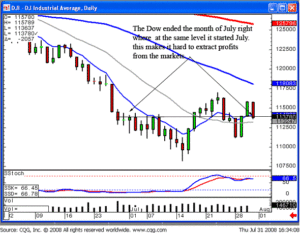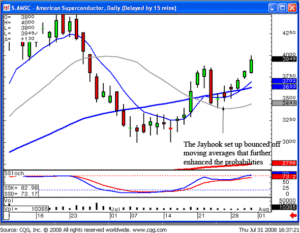Quick Look at Stock Trading Terminology for Beginner Investors
Understanding stock trading terminology is crucial before beginning a stock investing career. This article provides a good place for you to start!
Stock Trading Terminology: A Few Simple Terms
Capital Gain
The amount in which as asset’s selling price exceeds its initial purchase price. This is the profit that results from the sale of an investment and generally receives more favorable tax treatment than ordinary gains. An investment that hasn’t been sold yet but would result in profit if sold is an unrealized gain.
Equity
Ownership interest in a corporation in the form of common stock or preferred stock. It is also referred to as shareholders equity, net worth, or book value.
Ticker Symbol
A system of letters used to identify stocks or mutual funds. They are up to three letters and are used for stocks that are listed and traded on a stock exchange. Symbols with four letters are used for NASAQ stocks and symbols with five letters ending in x are used for mutual funds.
Volatility
The state at which the price of a security moves up or down and is found by calculating the annualized standard deviations of daily change in price. High volatility is when a stock moves up and down rapidly over short periods of time. If the stock price almost never changes then it has low volatility.
Understanding basic stock trading terminology is the first step towards a trading career.
Stock Trading Terminology: Methods
Technical Analysis
Technical analysis is the method of evaluating securities by analyzing market data through the use of stock charts of price, volume, and open interest, in order to predict future market trends. This method assumes that market psychology influences trading in a fashion that enables prediction of when a stock will rise or fall. The intrinsic value of the security is not considered, but instead the overall state of the market is examined.
Fundamental Analysis
Fundamental analysis is the method used to evaluate the value of a security in which the investor carefully examines the company’s financials, operation, earnings, growth potential, assets, debt, management, products and competition. This type of analysis takes into account the variables that directly relate to the company itself.
Once you have an understanding of the stock trading methods that you can use, continue to learn other stock trading terminology in relation to these methods.
Stock Market Terminology: Strategies
Buy and Hold
This investment strategy takes place when stocks are bought and held for long periods of time, regardless of the market’s fluctuations. It is based on the assumption that stock prices will increase over the next 10-20 years and the market as a whole will rise despite short-term fluctuations because of rising inflation or business cycles.
Growth Strategy
This investing strategy is based on investing in companies that are growing faster than others in the same industry. The goal is to generate capital gains rather than dividends.
Short Selling
This is the borrowing of a security or commodity futures contract from a broker and selling it with the understanding that is must later be bought back and returned to the broker. This strategy aims to profit from falling prices of stock and the investor’s stock broker will borrow the shares with the promise that the investor will return them later. The profit is the difference at which the stock was sold and the cost to buy it back, minus any expenses and commissions.
Now that you have the basic stock trading terminology down, and you know which methods you will practice, you are on your way to becoming a stock trader. Continue to research online terminology associated with trading stocks and take the necessary tutorials and training courses so that you can get started in your stock trading career. Good luck!
Market Direction
What it is the market telling us? Japanese Rice traders had the ability to analyze which direction the market was moving based upon what the signals were revealing. They could do this when analyzing a single trading entity such as Rice. Whether a single trading entity or a market index, the same information is going to be conveyed with candlestick formations. Having the knowledge of the general direction of a trading entity/market provides a huge advantage for extracting profits of the markets. This may seem like an oversimplified statement, but most investment techniques do not have the capabilities to analyze trends as they are in progress. Many investment techniques are used for projecting where a reversal of a current trend may occur.Candlestick signals produce information that makes the evaluation of an in-progress trend much easier to analyze. Being able to assess whether a market trend is in an up trend, downtrend, or sideways mode becomes very important for implementing trading strategies. Obviously, the trading strategy for up trending market will be different than a down trending market. A trading strategy will be completely different when the market is choppy or just moving sideways. Although this may seem like an oversimplified statement, as a candlestick investor, the application of trading strategies becomes much greater refined when knowing what the overall market trend is doing.
Evaluating what the overall market is doing is merely analyzing what it has been doing. As seen in the Dow chart, there has not been any great decisive move for any great length of time one way or the other. What is the overall market trend? If you will notice, the Dow closed the month of July almost at the same level it started July. The sideways movement for the month does not yet indicate whether this is a bounce in a downtrend a market or the bottoming action for the next uptrend. The market conditions over the next few days will have to provide more evidence one way or the other.

DOW
The point of investing is to put funds into situations that provide a higher degree of probability for making profits. The candlestick signals are instrumental for projecting where a trend is moving. They are also as instrumental for analyzing that there is no trend. Obviously, the ability to make profits in a sideways moving market becomes much more difficult. For many investors, it is difficult for them to make money even when the markets are trending up or down. “Sell in May and go away” it is a normal stock market adage. Does that always hold true? Not always, and that is where the utilization of candlestick signals becomes more beneficial. There will be summer rallies. Candlestick analysis will identify those rallies, even though they do not occur very often. Even though most summers are not worth trading, candlestick analysis will identify the ones that are and also identify what would be considered a normal summer blahs. Why is this important? Just like any other activity or job, it is good to get away from it for a while so that the mind, body, and spirit can rejuvenate.
There are positions that are still making money in this market. Identifying them is a function of knowing the candlestick signals and candlestick patterns. As seen in the AMSC recommendation, the Jay hook pattern has produced a good percentage profit despite what the market action was doing. Candlestick signals and patterns have the statistical proven capability of producing good profits during any market conditions.

AMSC
The question now becomes whether it is worth staying by the computer screen and trying to eke out some profits or go enjoy summer activities. If the market does not providing good opportunities, save your mental energy for when the market is producing good potential price moves. This may sound like investment sacrilege, to advise people to take a break from investing, but making money in the markets require each individual’s mental capabilities to be as sharp as possible. Without some rest periods, the mind can become dull and sluggish.
Successful investing is the combination of utilizing a successful trading program and applying the correct mental thought processes to that program. Both are required.
Chat session tonight at 8 p.m. ET, open to everybody. Bring the kids. Invite the neighbors. Click here for instructions. If you already have HotComm installed, click here to connect.
Good investing,
The Candlestick Forum Team
Speak Your Mind